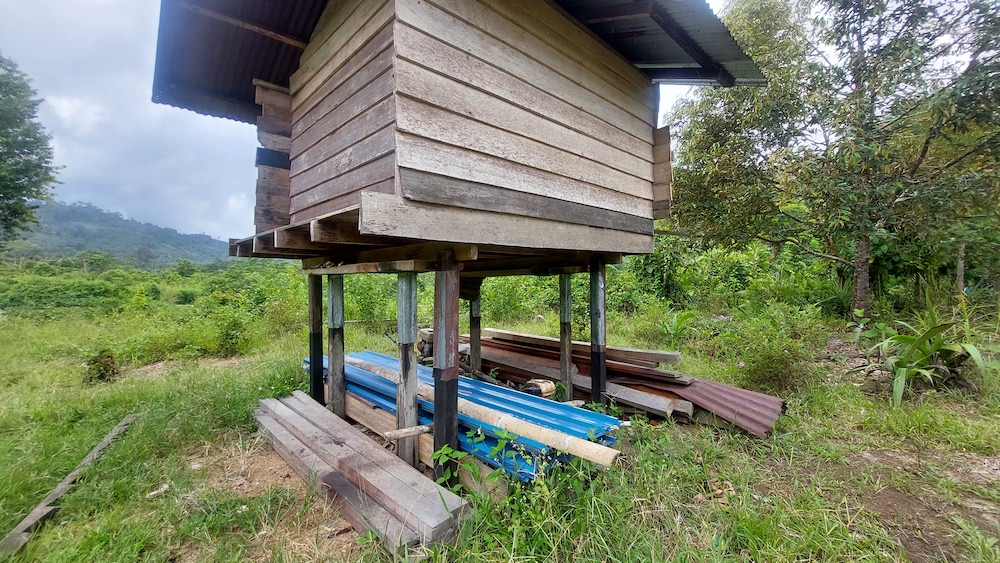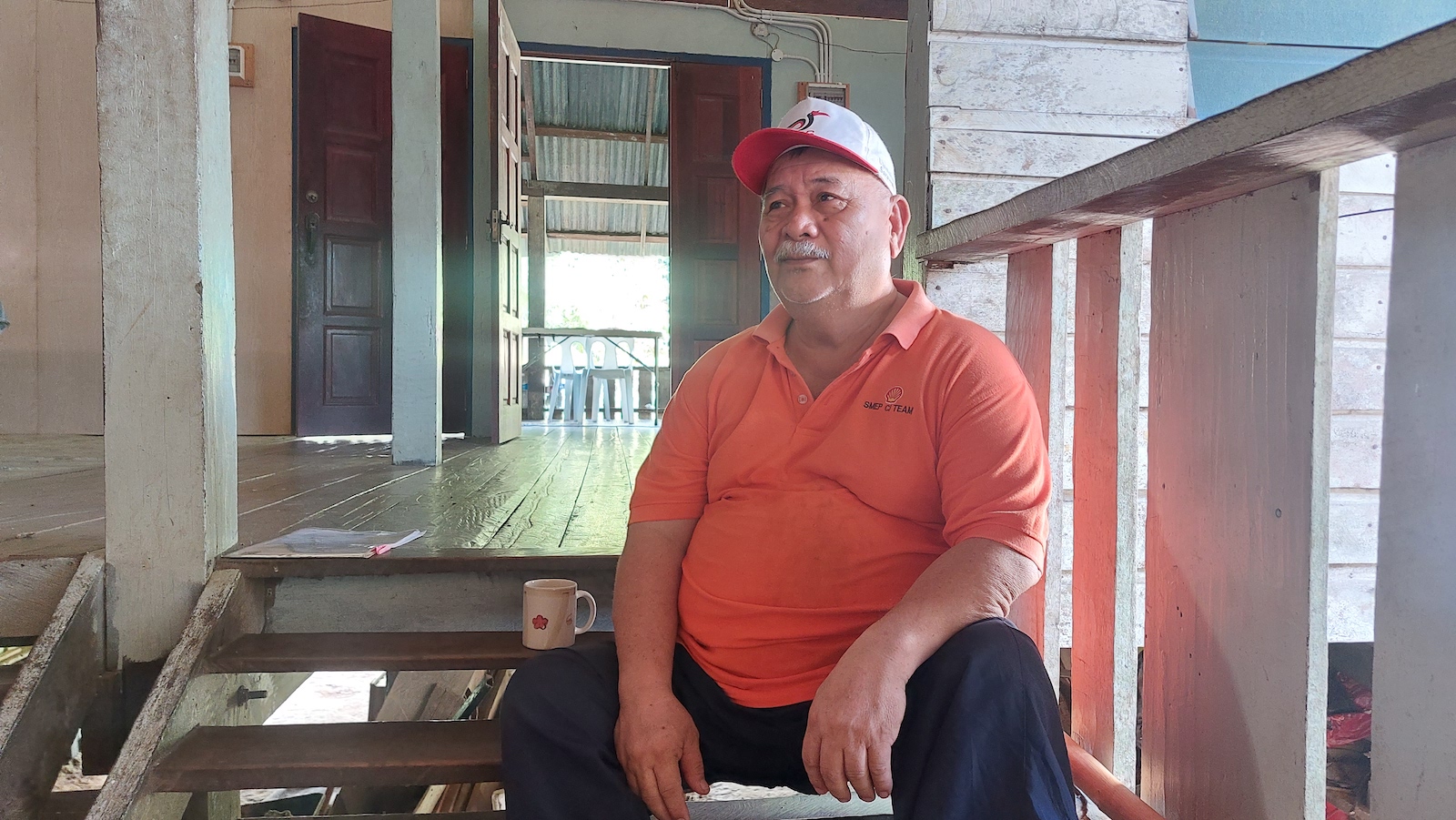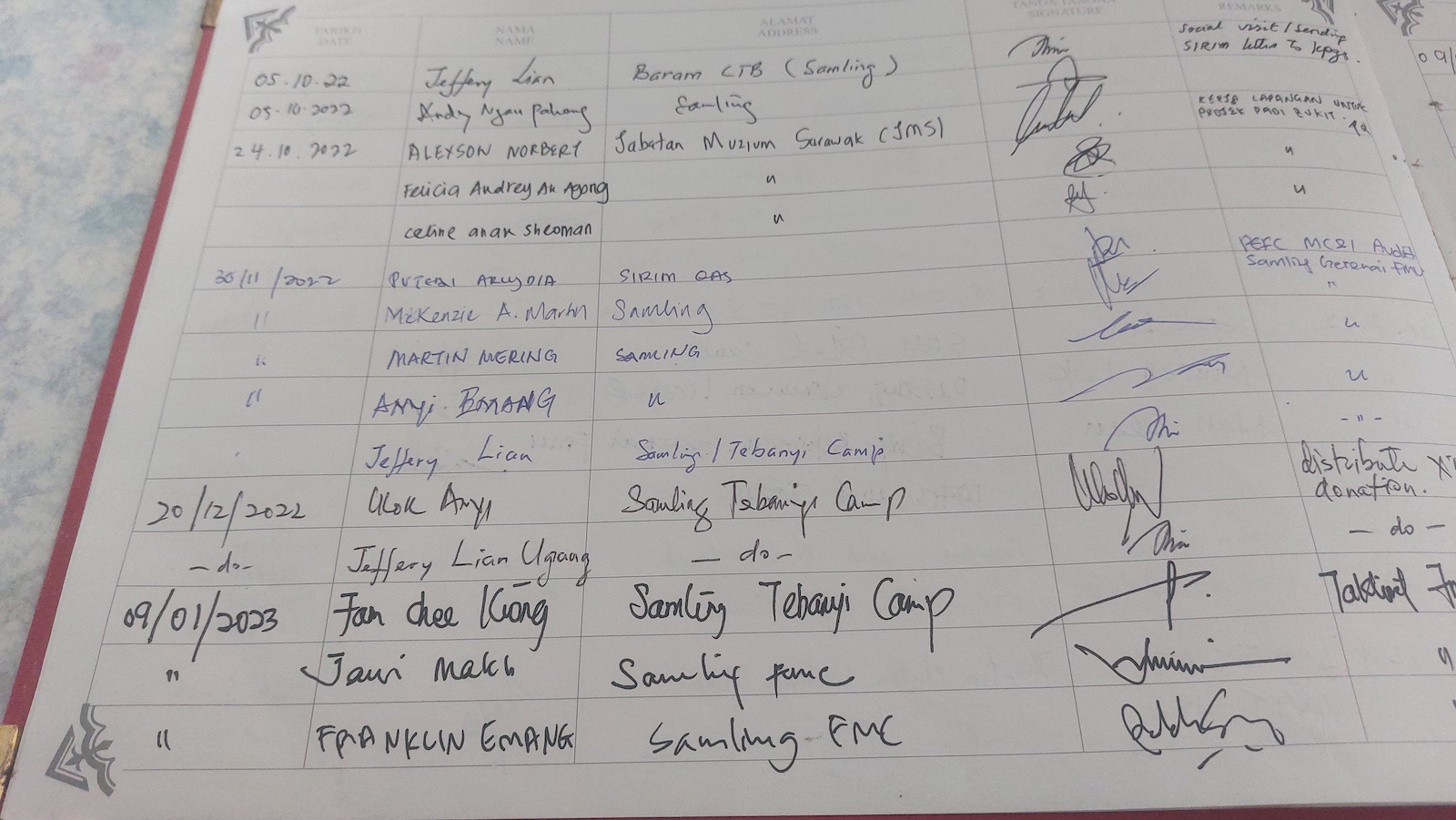- Malaysian timber giant Samling has held logging concessions in the Bornean state of Sarawak since the 1970s, many of them overlapping with Indigenous customary lands.
- In a recently settled lawsuit, Samling described complaints against its operations in Sarawak as defamatory.
- Mongabay recently traveled to Sarawak to meet with Indigenous and local leaders, who said that while the company has recently made more efforts to meet with villages affected by logging, it’s not doing much to address their complaints and suggestions.
UPPER BARAM, Malaysia — When James Nyurang became headman of Tanjong Tepalit village in 2008, he learned from his predecessor — and father — of the terms set by timber giant Samling Group.
When the company began cutting trees and leveling roads in Tanjong Tepalit in the 1990s, the headman of this Kenyah Indigenous village along Sarawak’s Baram River signed a deal with Samling. They agreed that the company would pay a commission of 0.50 ringgit (10.5 U.S. cents) for every metric ton of timber extracted and transported out along the edges of newly built logging roads. Timber cleared from the wider areas that branched off these roads were excluded from the community’s compensation deal.
As Samling Group grew into an international timber conglomerate, Tanjong Tepalit modernized slowly alongside it, but Nyurang felt his community had been compelled into making that deal and should have received more for the dense forests and clean waters they lost three decades ago.
Nyurang says he was surprised to meet Samling again last year. Though he’s no longer a headman, he says the company sought him out to discuss complaints raised by residents of his and neighboring villages against one of the company’s concessions, the Gerenai Forest Management Unit, which abuts Nyurang’s village.

The retired teacher and community prayer leader studied Samling’s plans and made suggestions. Nyurang says he recommended ways to keep the community informed, from leaving hard copies of maps and meeting minutes at Indigenous longhouses, to urging the community to form a representative council for the village. Nyurang says company representatives took notes and held a subsequent informational session, but he says Samling largely appeared to disregard his advice.
“What I fear is they take for granted that these people [in our village] understand what they [Samling] have tried to explain to them, and take for granted that they agree to the terms and conditions of the meeting,” Nyurang says.
Samling Group, once known for its rapid and ravenous consumption of Sarawak’s forests and conflicts with Indigenous residents who rely on the once-lush rainforest, now says it’s following sustainability and corporate responsibility guidelines set by the Malaysian government to participate in the international timber trade. The company also says its operations, including those that have faced opposition from activists and conservationists, are in compliance with local laws. But residents of Sarawak’s Upper Baram region say they’ve never been truly informed of the company’s intentions, and say they worry that logging might affect their lives and further deplete the forests around them.
After Mongabay made several attempts and calls to Samling Group to review comments from Upper Baram communities, Samling declined to comment, telling a reporter to “refer to earlier responses to your queries.” But when a local NGO publicized Indigenous communities’ concerns that the company wasn’t following the government’s protocol for timber concessions, Samling called it defamatory.

Samling has a string of state-sanctioned timber concessions across Sarawak’s dense rainforests dating back to 1976, and in 2022 reportedly exported a total value of 544 million ringgit ($115 million) in timber products. The company currently has three forest management units certified under the Malaysian Timber Certification Scheme, a national system of vetting timber operations that’s the pathway to international sustainability certification and thus lucrative buyers. Samling already has licenses to log across Sarawak state, but with increasing international scrutiny on the timber industry, companies seek outside certification to demonstrate they’re doing minimal harm and fully informing and gaining consent from those who live in and around their concessions.
However, the company has recently lost MTCS certification for a fourth forest management unit, Ravenscourt, with the auditing body, Sirim Qas International, suspending its certificate in March and revoking it in July. The auditing firm’s previous review of the Ravenscourt FMU, which was published last May, raised concerns that Samling did not properly inform residents about how to express their concerns and left no paper trail of its activities or dialogue with village members.
The company also recently drew condemnation from civil society groups around the world after it sued SAVE Rivers, an Indigenous-led NGO that published articles alleging that Samling had rushed through the certification process for two of its FMUs, and then began logging beyond the boundaries to which it was confined by the certified concessions. The company dropped that lawsuit Sept. 18 after both parties signed a statement agreeing that “the welfare of the local community remain their priority.”
Mongabay visited communities in and around the certified Gerenai FMU, as well as other Samling concessions in the Upper Baram region that didn’t receive MTCS certification, to check the claims that Samling called defamatory in its now-settled lawsuit against SAVE Rivers. Residents tell Mongabay that Samling is increasingly visiting to ask their opinion, but that they feel the information sessions are insufficient and the representatives unobliging to residents’ requests or concerns.


Fear of repeating the past
Samling hasn’t logged near Long Lamam, a Penan village in Upper Baram, since the 1990s, but residents still recall the company’s entry three decades ago.
Jackson Gut, a boat driver who lives in the village, says Samling first started logging in the 1990s on land the community used for shifting agriculture, but that the company viewed as included in a timber license held by subsidiary Samling Plywood (Lawas). After losing their fruit trees and sago palms, which provide the formerly nomadic population’s gummy staple food naok, Long Lamam and neighboring villages blocked the company from traveling to a logging site in 1993. Gut says he was detained for two weeks before he was able to return to Long Lamam.
In August, the boat driver heard rumors that Samling planned to clear logs along a timber road to nearby Ba Data Bila village. Long Lamam is among a group of Penan villages that regularly unite to blockade logging activities, mostly recently joining two other villages to stop logging near the Batu Siman Mountains in 2021 and 2022. If Ba Data Bila decides to blockade, Gut says he would join. “We never know when we have to be ready,” he tells Mongabay.
Long Lamam’s headman, Ballang Toy, says Samling has offered the village supplies like free roofing materials, but he claims they offered these goods in exchange for new territories to clear land. In the end, the Sarawak Forestry Department agreed to give the village metal roofing in 2019 and Samling stepped in to deliver it, Toy says.
Dennis Ngau, a state legislator representing the Upper Baram area, says logging companies like Samling generally provide infrastructure like roads and bridges when the government can’t afford to do so, He adds residents are largely grateful to Samling for the assistance.
But Toy says he feels Samling was looking for an entrance into Long Lamam’s native customary land, which the community has mapped but for which it has not gained legal recognition from the government.


A New System?
The residents of Long Moh, a Kenyah Indigenous village around 17 kilometers (11 miles) southeast of Long Lamam, perhaps unwittingly sit on the border of Sarawak’s latest experiment in national forest licensing.
To the village’s north is a Samling concession licensed and certified by the government’s previous program, called the Sarawak Timber Legality Verification System, which was developed as a voluntary system for potential trade with the European Union.
Some of Long Moh’s shifting agriculture areas are included in that northern concession, but the village itself is located inside the Gerenai FMU to the south, which received a forest management certificate under the MTCS, granted through 2025.
Michael, not his real name, a farmer and resident in Long Moh, says his community had two run-ins with Samling workers, and he walked away from those confrontations feeling ignored.
In 2019, Samling began cutting trees in an area the villagers call Bekia, which is used by the community for agricultural land and also housed meranti trees, a tropical hardwood. The farmland falls within the company’s licensed area, but Samling and other licensees are required to exclude from their operations land that is of high conservation value as well as areas significant to Indigenous residents, including shifting agricultural land like Bekia.
Michael, who requested his real name not be used due to fear of retaliation by the company, says he was among a group of Long Moh residents who raised concerns to Samling workers after they witnessed the company clearing trees beginning in 2018. He says they asked multiple times for compensation for damage done and trees taken, but the workers ignored them, and dismissed their concerns when they raised issues at formal meetings with Samling.
“I think Samling is not following what we say to them,” he says. “When we speak they don’t care about that.”
Samling then undertook activity in 2020, according to residents, at yet another of Long Moh’s shifting agriculture sites, called Jekitan — or, for the company, an area within its Gerenai FMU. After trying to negotiate with Samling representatives in person, residents sent letters to the company.
Michael says he’s worried Samling is trying to convince Long Moh residents to allow workers to remove trees and flatten their farmland with what he calls “empty promises” of compensation. He says “they make sure we’re happy to see them, and if we are happy, OK, then they will act.”
Residents sent at least two letters to Samling in late 2020, demanding compensation of up to 3.35 million ringgit (almost $800,000 at the time) for logging and environmental damage in three areas. The second letter, which was seen by Mongabay, had more than 200 signatures. Samling wrote in response in March 2021 that it was “puzzled” by Long Moh’s claim and disputed that the company had trespassed into Long Moh areas, adding there was “no basis” for Samling to provide any compensation to the village.

Stanley Kuleh, another Long Moh resident and current secretary of the village leadership, says he thinks the community’s attempt to raise this issue to Samling via letters struck a nerve with the company. He notes that the company threatened legal action against his village in its 2021 response letter, and that this dispute was again referenced in Samling’s defamation suit against the Miri-based organization SAVE Rivers, after the NGO republished Long Moh’s concerns in a blog post.
“When we used the word ‘encroach’ [in the letter] I think [Samling] were very sensitive to that because the word ‘encroach’ is a very strong legal term, it means when you obviously enter a premise or area without the knowledge of the owner, which is true!” Kuleh says.
Kuleh says he feels Samling’s attempts to drag this dispute into a courtroom was threatening to the community and harmed their chances of engagement.
Legal action remains a concern among Long Moh residents: though Samling settled its dispute with SAVE Rivers, one resident withdrew his testimony from Mongabay fearing his comments would cause more problems with the company.
Kuleh says he saw parallels between Samling’s treatment of residents’ concerns now with its actions in the 1990s.
Recalling the village’s early encounters with Samling, Kuleh says residents only realized that Samling began industrial-scale logging after the Moh River turned a murky brown and residents began investigating. After facing community complaints about the clearing, Samling promised to build a new longhouse for the village in the late 1990s. But Kuleh says Samling only provided “sick,” broken-down machinery to develop the village and never completed the longhouse, leaving a cleared and empty plot on the village’s land. “It’s obvious that they’re not sensitive to the local communities’ needs,” he says. “If nobody asks [for anything], they just keep quiet.”


Defining consent
In the past two years, the most frequent visitor in Long Moh village’s guestbook is Samling: 23 company representatives passed through the village between March 2022 and August 2023, or more than half of Long Moh’s visitors, according to signatures in the book.
Even though Samling was frequently visiting Long Moh, Kuleh says he felt their efforts to engage the village were missing the mark.
“This engagement is only done after so much critique,” he says. “They should have done it long before that, so now you’re only doing corrective action when actually you should take this as a preventive move.”
Residents of multiple communities say they also had recent visits from Samling as well as Sirim Qas International, the firm required to audit FMUs under the country’s timber certification program. But even after multiple site visits, the villagers say they still don’t feel informed or able to express their concerns.
Ngau, the Sarawak state representative, tells Mongabay that the government created the FMU system to have more control over logging companies. He adds there’s no need for the government to improve the FMU scheme, the certification process, or the methods for gaining consent from residents.
Ngau says he believes the government’s requirements for FMUs are working because logging companies are having to work hard to meet them. He adds that auditors and the government monitor the companies’ progress, and many still receive approval to keep the MTCS certification.
“I know that people are trying to twist the thing around to make the people confused, but in all honesty I can say this is genuine [goodwill] from the government,” Ngau says.
When Nyurang, of Tanjong Tepalit village inside the Gerenai FMU, was called to meet Samling, he enumerated many concerns, he says. For example, Samling had placed concession boundary markers in his village without explanation. He adds that in past meetings with the entire village, he and others suggested that Samling give back to the community by repairing the logging road into Tanjong Tepalit. But the company refused, he says, on the basis that it hadn’t earned sufficient funds from around the village.

Nyurang also noticed the representatives focused on a coalition of communities that residents formed in September 2019, the Gerenai Community Rights Action Committee, seemingly concerned that it would resist the FMU.
“He kept asking me what is the purpose of this GCRAC, are they going to fight against Samling or what? And I told him we are not going to fight Samling,” he says, adding that they came together to raise questions about what the FMU would mean.
More worrying to Nyurang, he says, was Samling’s response when he asked when it would present a new contract and commission rate to Tanjong Tepalit before the start of logging near the village in 2025. The company replied that it was “too early to discuss” logging near Tanjong Tepalit, Nyurang says, referring to notes he took after meeting with the company.
Asked if he feels Samling listened to his complaints, Nyurang says it was difficult to get the company’s attention. He also questions its decision to sue SAVE Rivers, which only republished his and other residents’ experiences, he says.
“After all, this is not from SAVE Rivers. These are the voices of the people, complaints from the communities,” Nyurang says.
The only way to truly protect their forest is to make it into a protected area, at least according to Penan Indigenous residents in Long Lamam. The Penan people recently celebrated the establishment of the long-planned Upper Baram Forest Area, a protected landscape initially devised in 2010 that gained international donations and government endorsement in recent years.
Langup Nyo, a member of the forest area committee representing Long Lamam, says he sees the establishment of a protected area as a defense against Samling. He adds that since the company entered the area in the 1990s, it hasn’t informed Penan villages of when it will clear around their land.
“This shows that we have our rights” to the land, Nyo says of the Upper Baram Forest Area. “The company first has to come to us, whether they want to do an activity or not. We will have the rights.”
Banner image: A man steers his motorboat near a sign demarcating the border of two Samling timber concessions near Long Moh village on August 26, 2023. Image by Danielle Keeton-Olsen for Mongabay.
Sarawak Indigenous NGO squeezed by defamation case, silenced from reporting alleged logging
FEEDBACK: Use this form to send a message to the author of this post. If you want to post a public comment, you can do that at the bottom of the page.
